Expensive Quad Sockets vs. Ubiquitous Dual Sockets
by Johan De Gelas on October 6, 2009 1:00 AM EST- Posted in
- IT Computing
SAP S&D 2-Tier
| SAP S&D 2-Tier | |
| Operating System | Windows 2008 Enterprise Edition |
| Software | SAP ERP 6.0 Enhancement package 4 |
| Benchmark software | Industry Standard benchmark version 2009 |
| Typical error margin | Very low |
The SAP SD (sales and distribution, 2-tier internet configuration) benchmark is an interesting benchmark as it is a real world client-server application. We decided to take a look at SAP's benchmark database. The results below all run on Windows 2003 Enterprise Edition and MS SQL Server 2005 database (both 64-bit). Every "2-tier Sales & Distribution" benchmark was performed with SAP's latest ERP 6 enhancement package 4. These results are NOT comparable with any benchmark performed before 2009. The new "2009" version of the benchmark obtains scores which are 25% lower. We analyzed the SAP Benchmark in-depth in one of our previous server oriented articles. The profile of the benchmark has remained the same:
- Very parallel resulting in excellent scaling
- Low to medium IPC, mostly due to "branchy" code
- Somewhat limited by memory bandwidth
- Likes large caches (memory latency!)
- Very sensitive to sync ("cache coherency") latency
And here are the results:

Some of you may have already made this analysis: the one year old Quad Xeon platform is outperformed by servers which are three times cheaper. The best dual Xeon makes the Quad Xeon look ridiculous as it outruns the latter by 15%. The Quad Opteron 2389 2.9 is getting a beating too, but his big brother, the Opteron 8435, takes revenge by running circles around the Intel hex-core: it is no less than 50% faster!
While performance is not the only factor to consider, the least you expect from a quad platform is that it offers somewhat better performance than a cheaper dual socket. This is exactly what we have been discussing in our "General IT" blog: the hex-core Opteron may tip the balance back in favor of a quad socket platform for a part of the server market. We are not impressed by the 30% performance advantage of a 24-core over an 8-core, and those looking for the highest raw performance will probably be disappointed. But for a large part of the market, performance is only one of the factors, and the 30% extra may well be good enough to convince people to consider a quad socket platform. Other factors like more memory and expansion slots, slightly better RAS capabilities and less power for the same number of applications might make a quad socket server a better choice for those people.










32 Comments
View All Comments
rbbot - Tuesday, October 6, 2009 - link
Surely the high price of 8GB Dimms isn't going to last very long, especially with Samsung about to launch 16GB parts soon.Calin - Wednesday, October 7, 2009 - link
8GB DIMMs have two markets: one would be upgrade from 4GB or 2GB parts in older servers, the other would be more memory in cheaper servers. As the demand can be high, it all depends on the supply - and if the supply is low, prices are high.So, don't count on the price of 8GB DIMMs to decrease soon
Candide08 - Tuesday, October 6, 2009 - link
One performance factor that has not improved much over the years is the decrease in percentage of performance gains for additional cores.A second core adds about 60% performance to the system.
Third, fourth, fifth and sixth cores all add lower (decreasing) percentages of real performance gains - due to multi-core overhead.
A dual socket dual core system (4 processors) seems like the sweet spot to our organization.
Calin - Wednesday, October 7, 2009 - link
If your load is enough to fit into four processors, then this is great. However, for some, this level of performance is not enough, and more performance is needed - even if paying four times as much for twice as much performancehifiaudio2 - Tuesday, October 6, 2009 - link
FYI the R710 can have up to 192gb of ram...12x16GB
not cheap :) but possible
JohanAnandtech - Tuesday, October 6, 2009 - link
at $300 per GB, or the price of 2 times 4 GB DIMMs, I don't think 16 GB DIMMs are going to be a big success right now. :-)wifiwolf - Wednesday, October 7, 2009 - link
for at least 5 years you meanmamisano - Tuesday, October 6, 2009 - link
Great article, just have a question about the power supplies. Why do the quad-core servers need a 1200W PSU if the highest measured load was 512W? I know you would like to have some head-room but it looks to me that a more efficient 750 - 900W PSU may have provided better power consumption results... or am I totally wrong? :)JarredWalton - Tuesday, October 6, 2009 - link
Maximum efficiency for most PSUs is obtains at a load of around 40-60% (give or take), so if you have a server running mostly under load you would want a PSU rated at roughly twice the load power. (Plus a bit of headroom, of course.)JohanAnandtech - Wednesday, October 7, 2009 - link
Actually, the best server PSUs are now at maximum efficiency (+/- 3%) between 30 and 95% load.For example:
http://www.supermicro.com/products/powersupply/80P...">http://www.supermicro.com/products/powersupply/80P...
And the reason why our quads are using 1000W PSUs (not 1200) is indeed that you need some headroom. We do not test the server with all DIMM slots filled and you also need to take in account that you need a lot more power when starting up.